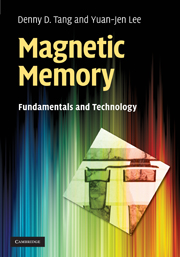Book contents
- Frontmatter
- Contents
- Preface
- Acknowledgments
- 1 Basic electromagnetism
- 2 Magnetic films
- 3 Properties of patterned ferromagnetic films
- 4 Magnetoresistance effects
- 5 Field-write mode MRAMs
- 6 Spin-torque-transfer mode MRAM
- 7 Applications of MTJ-based technology
- Appendix A Unit conversion table for cgs and SI units
- Appendix B Dimensions of units of magnetism
- Appendix C Physical constants
- Appendix D Gaussian distribution and quantile plots
- Appendix E Weibull distribution
- Appendix F Time-dependent dielectric breakdown (TDDB) of magnetic tunnel junction devices
- Appendix G Binomial distribution and Poisson distribution
- Appendix H Defect density and the breakdown/TMR distribution of MTJ devices
- Appendix I Fe, Ni and Co material parameters
- Appendix J Soft error, hard fail and design margin
- Index
- References
3 - Properties of patterned ferromagnetic films
Published online by Cambridge University Press: 06 July 2010
- Frontmatter
- Contents
- Preface
- Acknowledgments
- 1 Basic electromagnetism
- 2 Magnetic films
- 3 Properties of patterned ferromagnetic films
- 4 Magnetoresistance effects
- 5 Field-write mode MRAMs
- 6 Spin-torque-transfer mode MRAM
- 7 Applications of MTJ-based technology
- Appendix A Unit conversion table for cgs and SI units
- Appendix B Dimensions of units of magnetism
- Appendix C Physical constants
- Appendix D Gaussian distribution and quantile plots
- Appendix E Weibull distribution
- Appendix F Time-dependent dielectric breakdown (TDDB) of magnetic tunnel junction devices
- Appendix G Binomial distribution and Poisson distribution
- Appendix H Defect density and the breakdown/TMR distribution of MTJ devices
- Appendix I Fe, Ni and Co material parameters
- Appendix J Soft error, hard fail and design margin
- Index
- References
Summary
Introduction
The first part of this chapter describes the edge effects of patterned ferromagnetic films. The edge pole of the ferromagnetic film plays a significant role in the film properties, in particular, the magnetic energy state. Since the magnetic memory cells are made of tiny pieces of patterned film or film stack, the effects due to the end poles become a dominant factor governing the stability and switching behavior of the memory cell. The second part of this chapter deals with the switching properties of a small patterned film under an external magnetic field. A coherent switching model is introduced to describe the switching properties of the film. This is the basis of the write operation of the field-MRAM cells.
Edge poles and demagnetizing field
When a ferromagnetic thin film is patterned and etched into shapes, the magnetic poles at the edge of the film are exposed. Like the end of a bar magnet, magnetic flux emits from the poles at the edge of the thin film. Inside the film, the flux points in a direction opposite to the magnetization. The magnetic field associated with the end poles is called the demagnetizing field, HD. The magnitude of HD is position-dependent.
Consider a semi-infinite film of thickness t and saturation magnetization MS. The film extends from y = 0 in the +y-direction toward infinity and extends in both the +x- and –x-direction toward infinity (see Fig. 3.1).
- Type
- Chapter
- Information
- Magnetic MemoryFundamentals and Technology, pp. 51 - 73Publisher: Cambridge University PressPrint publication year: 2010

